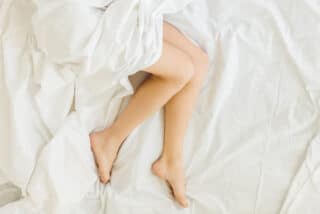
More Chiropractic Care Articles
Restless Legs Syndrome

A mid 40’s female patient visited her clinic to report weird sensations in her legs every night for the past four months with unknown causes. Her symptoms included numbness and feeling as if a bug were moving on her legs. She had been taking pain medication for two months, but that did not provide any relief. She believed the cause was sciatica due to lower back nerve pinching but evidence showed no results. Under further evaluation from a neurologist, it was concluded that restless leg syndrome (RLS) was the proper diagnosis.
She has since been under chiropractic care. Her symptoms are getting better with chiropractic and acupuncture treatments, so she is continuing her treatments.
RLS causes uncomfortable sensations in the legs and an irresistible urge to move them. Symptoms commonly occur in the late afternoon or evening hours and are most severe at night when a person is resting, such as sitting or lying in bed.
Being inactive or sitting at extended periods, like taking airplane trips or watching a movie can also trigger RLS. Since symptoms are triggered by resting, or attempting to sleep, RLS is classified as a sleep disorder. It is also a movement disorder since people are forced to move their legs for relief.
It is estimated that up to 7-10 percent of the U.S. population may have RLS. It occurs at any age in men and women, although women are more likely. Severe cases are found in those middle-aged or older, and the symptoms typically become more frequent and last longer with age.
More than 80 percent of those with RLS also experience periodic limb movement of sleep (PLMS), characterized by involuntary leg (and sometimes arm) twitching or jerking movements during sleep that typically occur every 15 to 40 seconds, sometimes throughout the night.
In most cases, the cause of RLS is unknown (called primary RLS). However, RLS has a genetic component and can be found in families where symptoms occur before age 40. Evidence indicates that low levels of iron in the brain may be responsible for RLS. Evidence also suggests that RLS is related to dysfunction in the basal ganglia, the section of the brain that controls movement using dopamine pathways. Disruption of these pathways results in involuntary movements. Individuals with Parkinson’s disease, another disorder of the basal ganglia’s dopamine pathway, have increased chance of developing RLS.
Treating associated medical conditions, such as peripheral neuropathy, diabetes, or iron deficiency anemia, may alleviate symptoms. Iron supplementation or medications are helpful, but no single medication effectively manages RLS. Trials of different drugs may be necessary but medications taken regularly may lose effect over time or may worsen conditions, making it necessary to change medications.
Iron supplements or other medications are the most common treatments but a concentration on lifestyle changes including less alcohol, less smoking, exercising and massage should be considered. Chiropractic care, physical therapy and acupuncture can also treat symptoms. Nutrition consultations or sleep therapy may also be necessary.

















